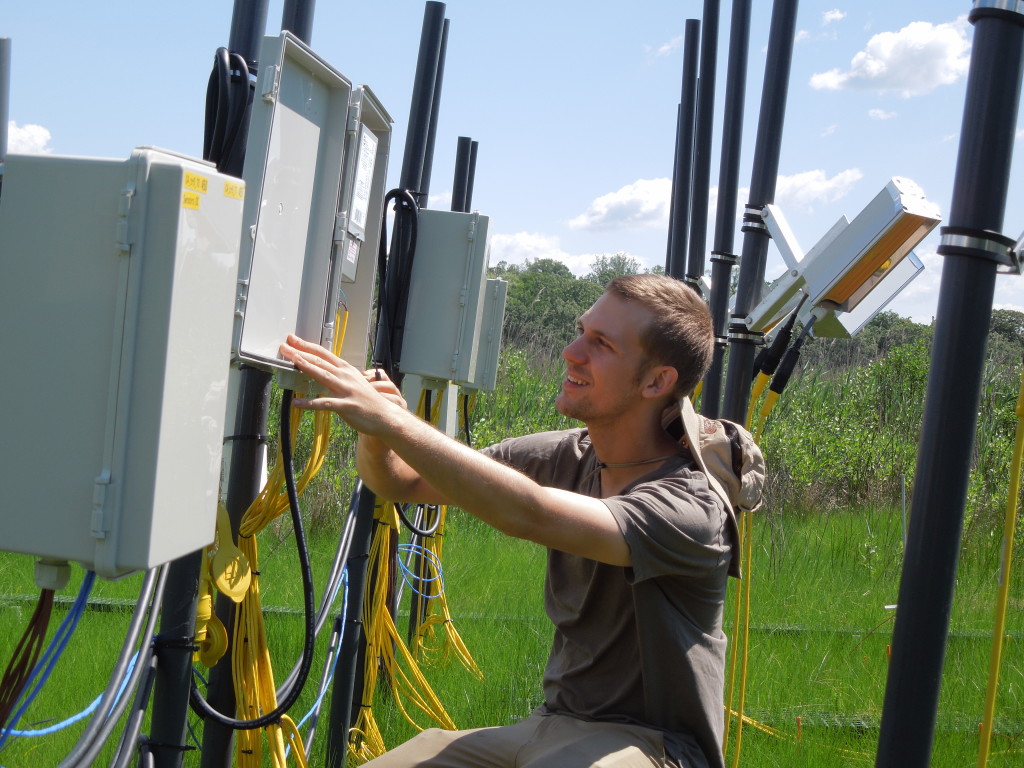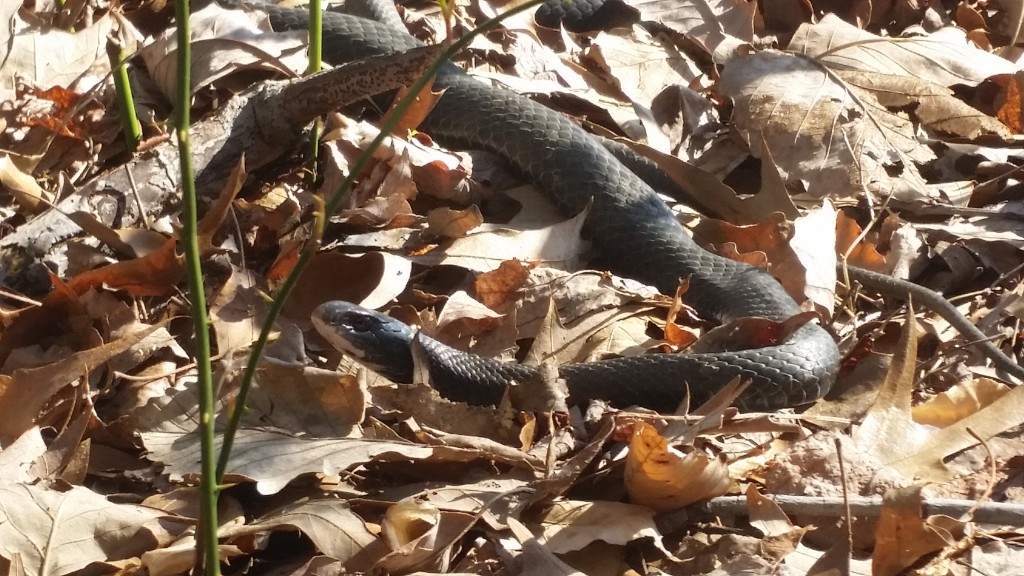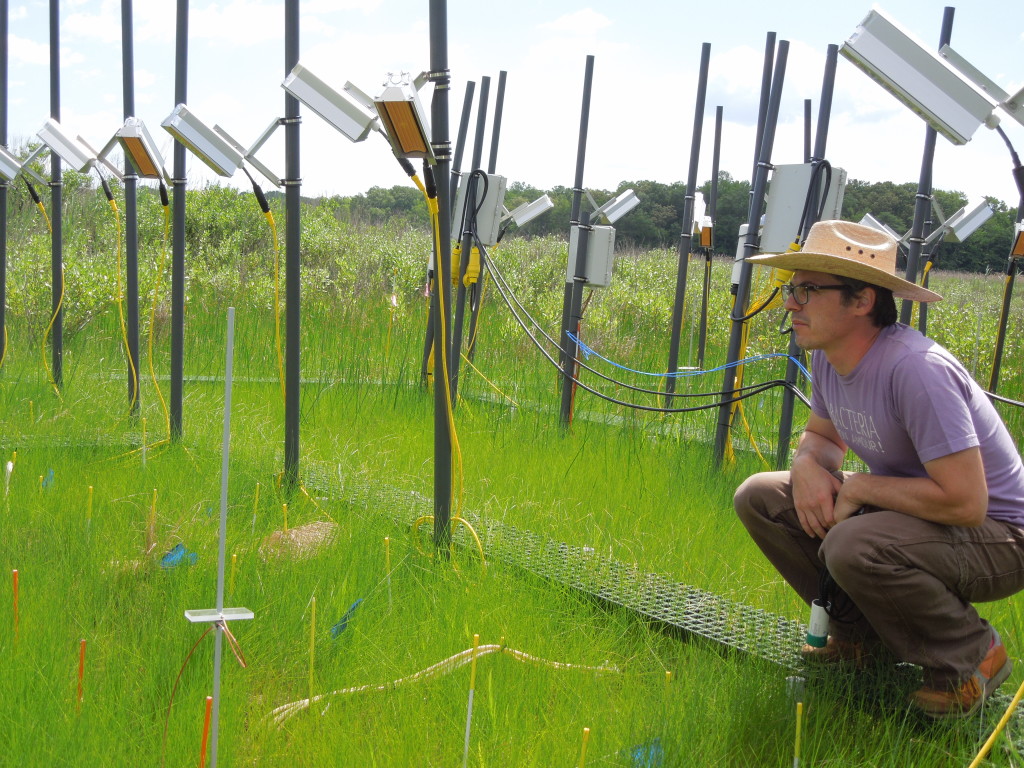by Joe Dawson, SERC research aide
Last fall, while volunteering in a plant lab at George Washington University in D.C., I heard about an experiment that was starting up at the Smithsonian Environmental Research Center (SERC). The project, a global warming simulation in the wetlands surrounding the Chesapeake Bay, was helmed by SERC research ecologist Roy Rich, an ecologist with an engineer’s mindset. I’ve been a wetlands enthusiast since I spotted my first blue Heron as a kid, and global climate change is, in my mind, the most pressing issue humans face today. I was ready to sign up. I met with Roy and asked the same questions I have since answered over and over again since joining the project in November:

Joe Dawson checks a control box for the underground heating cables that help raise temperature in the marsh plots. (Kristen Minogue/SERC)
“You’re heating up a swamp?” Yes.
“And adding CO2?” Yes.
“In a greenhouse?” No.
“Out in the open?” Yes.
“Umm, how?” Well…
In SERC’s Global Change Research Wetland (a.k.a. “wetland of the future”), we’re using infrared heat lamps above ground and heated wires buried below ground to warm up plots of land. Some plots will have plastic walls around them and will have carbon dioxide pumped in to simulate what a warmer world with higher CO2 concentrations would be like. The full name of the experiment is “Coastal Wetland Carbon Sequestration in a Warmer Climate,” but for now most scientists at SERC refer to it as simply the “global warming experiment.”
Other warming experiments have found that both higher temperatures and increased carbon spur plant growth. Our experiment takes this one step further. We want to know whether global warming will change the soil elevation of entire wetlands. As wetland plants grow, die off, and decompose, they add material to the soil below. The dead plant matter gets stacked higher and higher, and wetlands actually gain elevation over decades and centuries. If plants grow faster under higher temps, the soil might also build up faster. If that happens, wetlands could be a crucial buffer against rising ocean levels, growing as the ice caps melt and keeping coastal flooding at bay in wetland-protected areas.
Of course, when I first met Roy, the project existed only on paper. Last winter we faced the daunting task of actually building it.
Wading Through the Grunt Work

A network of infrared lamps and underground cables heat global warming plots in the Global Change Research Wetland. (Emily Li/SERC)
There’s a Bible verse about building a house on sand that could easily apply to setting up an experiment in a marsh. The ground is damp at its driest, a shallow pond at other times. Any structure that needs to stay put in the wetlands has to be kept in place with poles that go 3 feet or more into the ground. One cold day in February, I lined up 12 posts to make a walkway with then-SERC employee Tyler Pullen, and we dug holes 5 feet deep to set them up, only to realize that some were off-center by as much as a foot. Our hole-diggers had wandered off their markers in the soupy ground. It was ultimately our fault, but it didn’t help that the marsh has very few straight lines with which to orient ourselves.

A black rat snake basks in the sun in the Global Change Research Wetland. (SERC)
Working outside in the winter meant lots of wetland animals had migrated away or were hibernating. But when the weather warmed up, the animals came back in abundance. Ospreys circled in groups close to sundown; snapping turtles cropped up here and there; a pair of black rat snakes mated and sunned themselves outside the office; wild turkeys led their chicks in single-file lines through the forest; a neighbor’s beagle strutted past the Smithsonian truck early one morning, holding in its mouth a decapitated squirrel. Magical.

SERC ecologist Roy Rich helped spearhead and engineer the futuristic global warming experiment. (Kristen Minogue/SERC)
With an ambitious undertaking like this, we needed specialized help from other scientists. Surface elevation is a measurement that can be a little finicky to get right. Scientists from the Virginia Institute of Marine Science and U.S. Geological Survey came in to install soil elevation tables (SETs) and do the precise measurements. After running into an electrical problem in early May, Roy got some great advice from an electrical engineer who just happened to be at SERC’s Open House in May. It is fun to host other guests for a few days at a time, hear their stories and gain some knowledge.
The construction and deployment of this experiment has been at points difficult and frustrating, boring and monotonous. Talk to enough scientists, and you’ll find this is par for the course. Much of science is monotonous. This particular experiment will give us a sense of whether or not wetlands can protect the mainland from sea level rise. This is invaluable knowledge, and being part of it helps me push through digging posts five feet deep in a frozen marsh. But all the noble inspiration in the world can’t keep people working through truly miserable work.
Luckily, it isn’t truly miserable. Tyler, who now works for Maryland Environmental Service, always greeted hard work with a smile. While we spent a week pushing wires into the ground (yeah, that was our job for an entire week), I also had the company of Julia Mudd, a scientist who shared my background in improv comedy and is now pursuing a degree in scientific mapping and technology at St. Louis University. Even routine work is tolerable with people who are smart, funny, and who believe in the work they’re doing.
We flipped the switch on the project in early June. The lamps are hot; the ground is warm. We’ll need years of data to draw any conclusions about how the treatments are affecting the soil elevation. For now, we can pat ourselves on the back a little, fix things if they break, and sit on our hands while marsh grass grows and dies. Hopefully we will gain a little more knowledge, another dose of insight into how our world works.
Still curious? Learn more about more futuristic, long-term experiments going on at the Global Change Research Wetland.

